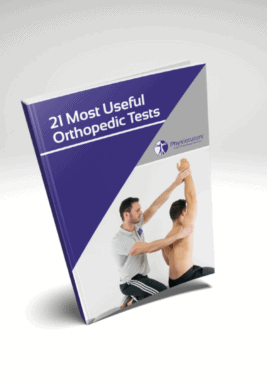Learn
Giving Way Test | Anterolateral Rotatory Instability
Jakob et al. (1981) proposed their test in order to reproduce anterior subluxation of the lateral tibial plateau with the patient in standing position. This position may be able to elicit the feeling of giving way of the knee more easily in muscular patients or those with active muscle guarding compared to a non-weightbearing test. However, this test variation has not been compared to a reference test so no diagnostic values are available and the clinical value remains questionable.
To conduct the test, the patient is standing and with his unaffected side leaning against the wall or the treatment table but is asked to distribute his weight equally on both feet.
Place your hands above and below the knee joint and apply a valgus force to the knee and move it into flexion.
In a positive test, the valgus force and flexion of the knee will elicit a jerk and the knee will give way. The patient may report this as the feeling of instability they experience.
21 OF THE MOST USEFUL ORTHOPAEDIC TESTS IN CLINICAL PRACTICE

Other common tests to assess for rotatory instability of the knee are:
- Slocum Test (Anterolateral Rotatory Instability)
- Crossover Test (Anterolateral Rotatory Instability)
- Lemaire Jolt Test (Anteromedial Rotatory instability)
- Reverse Pivot-Shift Test (Posterolateral Rotatory Instability)
- Dial Test (Posterolateral Rotatory Instability)
- Frog Leg Test (Posterolateral Rotatory Instability)
Like what you’re learning?
BUY THE FULL PHYSIOTUTORS ASSESSMENT BOOK
- 600+ Pages e-Book
- Interactive Content (Direct Video Demonstration, PubMed articles)
- Statistical Values for all Special Tests from the latest research
- Available in 🇬🇧 🇩🇪 🇫🇷 🇪🇸 🇮🇹 🇵🇹 🇹🇷
- And much more!








